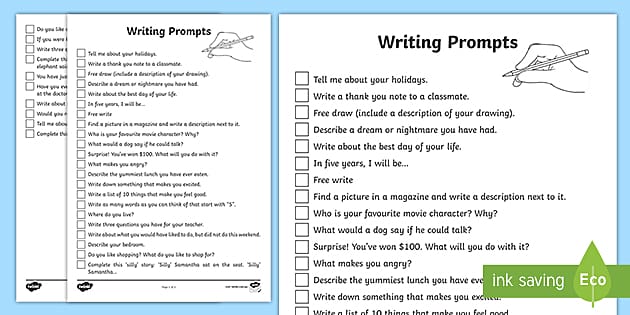1. Storytelling Marathon
A storytelling marathon is a unique activity that challenges students to collaborate and create a continuous story. Students are given a prompt, and each student contributes a sentence or two to continue the plot. This exercise encourages teamwork, quick thinking, and helps students practice fluency in their writing.
2. Random Writing Prompts
Have students draw random writing prompts from a hat or jar. These prompts can vary from situations to character traits to quirky phrases. Students must then use these prompts as inspiration for their stories, exploring new characters, settings, and themes.
3. Picture Prompts
Provide students with an intriguing image and ask them to write a story based on what they see. Encourage them to use the image as a catalyst for their imagination, delving into the world behind the scene. This activity promotes creative thinking and descriptive language skills.
4. Round-robin Storytelling
Divide the students into groups and give each group a stack of index cards with different story elements like characters, settings, and plot points. The first student in each group starts by writing an opening sentence using one of these elements. The card then goes to the next student who has to continue the story using a different element from their card, taking turns until the story concludes.
5. Poetry Collage
Students can create visual poetry by cutting out words and phrases from magazines or newspapers and arranging them into interesting combinations that tell a story or evoke emotions. This activity promotes experimentation with language and poetry while also allowing students to explore the connection between text and visuals.
6. Character Interviews
Students create a list of interview questions for one of their characters in their original story project or a character from existing literature. This activity encourages students to delve deeper into character development, whilst creating backstories that enrich their narrative.
7. Fictional News Articles
Challenge students to become journalists and write “news articles” set in the worlds of their stories. This exercise allows students to explore and expand on the plot and setting of their stories while practicing journalistic writing techniques.
8. Storyboarding
Using images or drawings, students construct a visual representation of their stories. This helps the students plan their narrative structure, organize ideas, and improve pacing. It can also aid them in identifying gaps in their story that need filling.
9. Alternate Endings
Students rewrite the conclusion of an existing story or create different endings for their narrative project. This activity encourages critical thinking and creativity, as it pushes students to explore alternative resolutions for their stories and understand how this can impact character development and theme.
10. Creative Writing Challenges
Assign specific creative challenges that force students to experiment with different writing styles or literary techniques. For example, writing a scene without using any adjectives, creating a story from multiple perspectives, rewriting a story from a different genre, etc. This activity helps students expand their understanding of various writing styles and narrative conventions while challenging them to stretch outside of their comfort zone.
These 10 creative writing activities provide opportunities for your students to hone their storytelling skills, dive into character development, explore new ideas, and experiment with different writing styles. By incorporating these activities into your lesson plans, you’ll not only boost student engagement but also inspire young writers to unleash their creativity and share their unique stories with the world.

